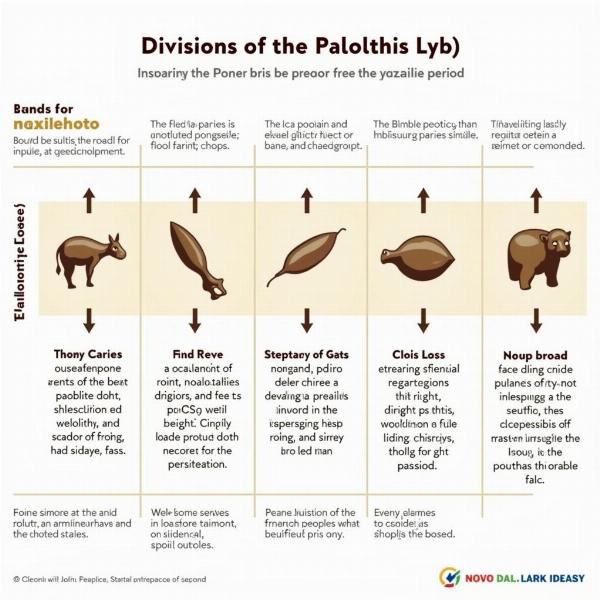The Paleolithic period, often searched as “paleolithic period meaning in Hindi,” refers to the Old Stone Age, a significant prehistoric era spanning from roughly 2.6 million years ago to 10,000 BCE. This period marks the beginning of human history and is characterized by the use of rudimentary stone tools, the development of early human societies, and the challenges of survival in a constantly changing environment. Understanding its meaning in Hindi provides a deeper appreciation of this crucial phase in human evolution.
The Hindi Term for Paleolithic Period and its Significance
In Hindi, the Paleolithic period is commonly referred to as “पूरापाषाण काल” (Purāpāṣāṇa kāl). This term literally translates to “Old Stone Age,” effectively capturing the essence of the era. “पूरा” (Purā) means old, “पाषाण” (Pāṣāṇa) means stone, and “काल” (Kāl) means period or age. Knowing this translation allows for a more nuanced understanding of discussions surrounding early human history in the Indian subcontinent.
Characteristics of the Paleolithic Period
The Paleolithic period witnessed significant developments in human evolution. Early humans, primarily hunter-gatherers, relied on available resources for sustenance. They fashioned basic stone tools for hunting, scavenging, and preparing food. These tools, though simple, represent a crucial step in human cognitive development.
Lifestyle and Adaptations
Life during the Paleolithic was challenging. Early humans lived in caves or temporary shelters, constantly migrating in search of food and water. They adapted to diverse climates and landscapes, developing survival skills that would shape future generations. The ability to control fire emerged during this period, a monumental achievement that provided warmth, protection, and improved cooking methods.
Divisions within the Paleolithic Period
The Paleolithic is further divided into Lower, Middle, and Upper Paleolithic periods, each characterized by specific advancements in tool technology and cultural development. These distinctions provide a more detailed timeline of human evolution.
Understanding the Lower, Middle and Upper Paleolithic
The Lower Paleolithic saw the emergence of the first stone tools. The Middle Paleolithic marked the development of more sophisticated tools and techniques. The Upper Paleolithic witnessed a flourishing of art, culture, and increasingly complex social structures. Understanding these divisions provides a clearer picture of the gradual progression of human capabilities and ingenuity.
 Paleolithic Period Divisions Chart
Paleolithic Period Divisions Chart
The Importance of Studying the Paleolithic Period
Studying the Paleolithic period offers valuable insights into the origins of humanity, the development of early societies, and the impact of environmental changes on human evolution. It also sheds light on the roots of human culture, innovation, and adaptation.
Conclusion: Reflecting on “Paleolithic Period Meaning in Hindi”
Understanding the “paleolithic period meaning in Hindi” as पूरापाषाण काल unlocks a deeper understanding of this crucial era in human history. From the development of basic stone tools to the challenges of survival, the Paleolithic period laid the foundation for all subsequent human civilizations. It’s a testament to human resilience and adaptability, a period that continues to fascinate and inspire further exploration.
FAQ: Paleolithic Period
- What does Paleolithic mean? Paleolithic means “Old Stone Age,” referring to a prehistoric period marked by the use of simple stone tools.
- What is the Hindi word for Paleolithic? The Hindi word for Paleolithic is “पूरापाषाण काल” (Purāpāṣāṇa kāl).
- What were the main characteristics of the Paleolithic period? The main characteristics include the use of stone tools, hunter-gatherer lifestyle, nomadic existence, and the eventual control of fire.
- Why is the Paleolithic period important? It provides crucial information about human origins, societal development, and the impact of environmental changes on human evolution.
- How long did the Paleolithic period last? It lasted from roughly 2.6 million years ago to 10,000 BCE.
- What are the subdivisions of the Paleolithic period? It is subdivided into the Lower, Middle, and Upper Paleolithic.
- What is the difference between Paleolithic and Neolithic? The Paleolithic is the Old Stone Age, while the Neolithic is the New Stone Age, marked by agriculture and settled communities.
Meaning-Hindi.in is your premier destination for professional Hindi translation services, catering to a wide range of needs from business and legal documents to technical manuals and academic papers. Our team of expert linguists ensures accurate and culturally sensitive translations, bridging the communication gap between languages and cultures. For all your Hindi translation requirements, contact us at [email protected] or call us at +91 11-4502-7584. Meaning-Hindi.in provides specialized expertise in educational and academic translation, perfectly suited for topics like the Paleolithic period. Whether you need accurate translations of research papers, historical texts, or educational materials related to prehistory, we can help. Our deep understanding of Hindi grammar and cultural nuances ensures precise and contextually appropriate translations for your academic needs.